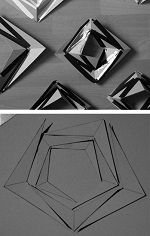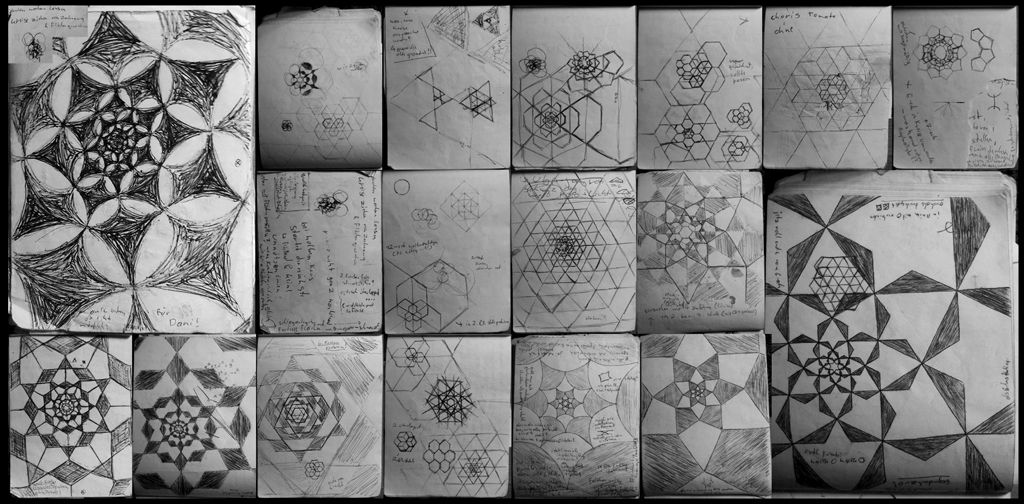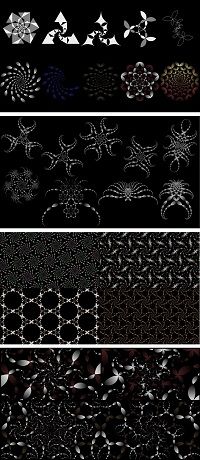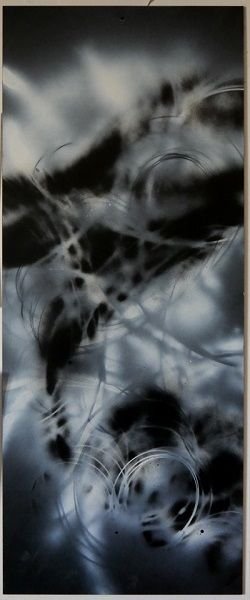You know, I want to introduce to you all those different branches of my artwork that all somehow are still interrelated with each other. In my last article I superficially illustrated some connections between my sculptural artwork and traveling. This time I also want to introduce something less 'substantial'. Still there are also relations to journeys and I even learned from it in a somehow similar way. I'd like to illustrate a bit of a section that has initially come up pretty unforeseen, it after a while waned but recently regained some of my attraction. Let's now have a look at emergence and evolution of my graphical artwork.

Sure, from the beginning of my structural explorations I've been making graphical sketches to examine geometrical interrelationships to figure out the effects on statics and dynamics of constructions – take a look at this post to learn more about those basics of my work. Anyway, someday this graphical examination started to develop a life of its own – one thing led to the other, upcoming aspects were continuously followed until those graphical developments and accompanying thoughts appeared to be completely relieved of any direct relation to their materialization.
It is to say that all this happened before I theoretically conceptualized the processes my artwork is based on in both general and detail. You'll see that it gave some interesting insights in those evolutionary developments of structures.
Another thing to be said is that – I never mentioned this yet – ..that I, probably not very surprisingly, have been documenting all sorts of possibly relevant thoughts for many years now. If I wonder if a particular thing is worth documenting, then this relevance is defined as already being given. I always carry a notebook with me and if one of them gets lost, it is indeed like Armageddon to me. I write things down to allow myself to continue thinking about something else, so even if implemented in my current thinking they're still being lost.
Anyway, you can imagine, that the topic of many of those thoughts is the process of thinking itself. So if I look at the drawings in my notebooks there are not just those that symbolize constructions and those that mainly play with geometrical interrelationships but also some that illustrate various ways of thinking. I don't want to go too deep into this topic for now, like many others it is worth its own article. Just to not let you hang in the middle of nowhere with this information – the first thoughts I remember being documented like this were dealing with the enlargement of one's own 'network of thoughts'. Specifically, it was about those blind alleys that always seemed very important to me because eventually this one chain of thought is connecting all those former blind ends and thus – now being able to withdraw from various sides – widening the established basis.
A conceptualization like this is clearly far easier to be documented as a simple drawing than in words – and yes, there is a close connection to traveling. ..I'm sorry that I don't take the time to find it for now.
Anyway, why I outline this is that regarding many of those (graphical) shapes having developed since then, there's a strong component that uptakes this connection of abstracting cognitive processing and related aspects. For sure you'll get to know some of them now or in the next couple of months.
So,
let's start with this point where the graphical process derived and diverged from construction-related approaches – sure, later on it also did and does find the way back to them. First there is to tell about a plan that led to several very different developments but that itself hasn't been followed since then – soon I will do so for sure.

The initial idea was to build an audio-sensitive room that would change its shape according to those peculiarities in sound being induced constantly. For this purpose I started experimentation on shape-shifting panels that could for example change the angles of their rhomboid outlines and thus effect the alignment of merging elements covering the space.
Coming closer to those graphics, transformable panels were designed that consist of a system of several smaller parts whereas those inner movements interrelate directly. One approach was to realize elements with inner parts that are varying in size but not in shape and by this self-similar repetition get closer to the center of the penal. Potential is expected to somehow be even higher for other functions than this initially aimed for – outlines don't change much but dynamics can serve as an opening/closing mechanism in the middle of the panels. Anyway, their self-similarity led me to the consideration to focus on those geometrical interrelationships also separately form their former purpose. Right next to some rhomboid studies I started to experimentally explore their peculiarities using CAD-tools.
Doing so it didn't take long to be astonished for the first time. I was working on repetitive square-shaped linear arrangements interlacing towards the center of the canvas. I soon tried to apply this structural principle again on itself. Thereby, every crossing of lines becomes a new center and there's now an endless repetition of all those centers towards an over-all-center in the middle. In the following step I once again did the same – every of those former-crossing-centers becomes a center of centers and they repeat endlessly towards the middle of the square. Also the 4th step of this geometrically limitless procedure was executed and even printed out, but for the mind it is somehow too hard to grasp. There's too much information to perceive, I guess the screen would need to be some meters wide to keep overview. Being quite overwhelmed about this finding at that time I even submitted this series to participate in the official Austrian graphic design competition.

Also various studies on polygonal arrangements are to be mentioned – like this continuous mirroring of odd-numbered polygons that illustrate some similarities to cognitive processes. Also others, some pentagonal alignments, appeared to be very interesting. They are a good example for convergent developments – a few months or maybe a year later I got to know about Penrose tiling that shows significant similarities.

The next big step
in this 'graphical journey' is closely related to traveling – this time not regarding its theoretical background but to the fact that this experimentation was processed when walking through Greece for 6 weeks. Still on the ship to Igoumenitsa I ruminated on arrangements of circles, again via self-similar centric collocation. I suddenly and unforeseen came to a solution that appeared as very, maybe even too simplistic. I was surprised and due to the lack of a computer couldn't know exactly if this whole thing was consentaneous with mathematical precision – indeed it was. Intersections appeared to be directly layering those of the subsequent elements forming a perfectly legit, surprisingly clean continuity.
Knowing that principles for the arrangement of circles are very similar to those of hexagons – just imagine the grid that is being formed by layers of piled up circles or the optimal assembly of drinking glasses – I started to examine possibilities to implement this quite abstract awareness to the graphical finding I just explained.

It took me a silly long time – about 3 weeks – to get to the solution, and then it happened to be – surprise, surprise – again completely simplistic. On the one side it's hard to accept this incapability of finding that simple solutions for such a long time. On the other hand it's something to laugh about and can furthermore even be seen as necessity. Additionally, I could figure out plenty of geometrically insufficient possibilities that despite not being that legit did widen the range of variation quite a bit.
After all, the last 3 weeks of this trip were not about finding an exact structure but about exploring the spectrum regarding various fillings of the surfaces given by the structure. Appearance can differ quite a lot at I knew that the need for digital continuation of those developments would probably lead to a whole lot of new insights.

When working on the computer,
the basic conditions are differing quite generally. Structures that look complex when drawn by hand can look very minimalistic when transferred to CAD. Not only the appearance differs, the endless extension of space or zooming in and out make for example scale to something very dynamic and changes of the viewpoint to something being perceived only very locally – it's easy to even get lost.

Variation is much more easy to execute by replication of some parts while varying others. Soon there were hundreds of diverse structures reaching from symbol-like appearance – also quite silly ones – via steady areal extents to – again – trials to apply the basic structural principle to itself.
It also got clear that this geometric approach is not only limited to hexagonal arrangements but can also be applicable to all regular polygons and even to less regular angles – that just makes me think of maybe going back and continue working on those developments.
Furthermore, this geometric principle can also be applied to dynamic graphics – animations. If fillings are executed one-sided, zooming can appear as rotation and vice versa.
Maybe because I somehow started getting a little lost in this open field I soon focused on this challenge of a reflexive execution of the geometric principle – and yes, after some time I found the solution, a multi-centered structure only consisting of hexagons – or circles. Again it did allow and now even suggest different styles of coloring. I had to try the next step. Reapplying the principle got a little tricky but again it worked. It was just fascinating to see those completely symmetrical and thus diverse but always somehow multidimensional structures.

After those developments quite a long time passed without working on graphics. Still, they became part of my theoretical studies. I already wrote about the evolutionary approach in my work in one of my articles and those graphical developments I'm introducing now – with all those branches, divergent directions of development, emerging 'families', variation and selection, unexpected insights and rising complexities – became one of the first sections to illustrate its fundamentals quite clearly. Also characteristics in sculptural developments then appeared to be very similar, so – disregarding all questions of aesthetics or geometric relevance – those developments were indeed very important for methodological elaboration.
After this long time
without any real focus on graphics it was only about one year ago that I unexpectedly came back to them – in a widely different manner. I was working on cutting the video clip from this event in Montpellier I also mentioned some weeks ago. In the very end of this video the point of view is getting closer to the center of the helically folded structure. Working on Blender, i saw some undefined polygonal characteristics and somehow felt the need of mirroring it and again start to graphically play with this pictorial information.
When doing so, it immediately became clear that there's a whole lot of further potential to examine. After some rectangular approaches I tried a more hexagonal one using the same basis – and again I was astonished. A wide range of shapes appeared, from very abstract to cellular-shaped and even animal-like formations, whereby all parts are connected, there are no straight lines and none of them is ending.
It was great to see those planned sculptural structures that are folded in an unplanned way to be put into order again and thereby showing completely unexpected shapes that again are interpreted when perceived.

I had to take a short break to let this sink in for a while.
Then I soon also realized some similar graphics based on other pictures; it was a new world for me, again one that could be explored endlessly. This could happen horizontally by trying more and more graphics using different basic information – ore this could be executed by further evolving the approach.
One very interesting aspect in the first of those graphical artpieces is that appearing shapes – or, lets say shapes being perceived – are differing according to the distance the observer has to the picture; while structures of a higher level are being grasped, interpretations of the details are being 'lost'.
So if this new approach would again be combined with the endless centric repetition explained above, due to scaling, perfect self-similarity would exist only geometrically, while – without any change of distance – our mind would lead us to see all those different shapes. ..definitely something worth to follow.
Furthermore, it would for example be possible to move the sector being mirrored by implementing the geometric principles in some real time application. Another approach is related to the fact that from an engineering aspect i never thought about kaleidoscopes before – now time seemed ready for that. I already mentioned that I did work on foldable plate structures, one of the next steps will be to design and construct variations of those transformable constructions as moving mirrors that would enable this graphical potential even without using a computer.
No one knows where this graphical journey with all its branches can lead to, I'll let you know about the progress :)
I do continue looking for not only sculptural shapes. For example – also related to mirroring: while last summer I for the first time went swimming with some of my objects, it was fascinating seeing all those shifting reflections wherever elements are plunging into the water while a big part of the structure seems to just disappear.

Recently,
also another graphical approach emerged – sculptural shapes are analogically being documented to 2-dimensional surfaces. While the geometric approach explained before – like conventional photographs in general – only send sculptural information to the planar graphical medium, this 'communication' – by transferring information for example by using spray paint – is somehow executed in both directions, information is being exchanged.
When shapes of sculptures are graphically documented in their unplanned folded states and related to the graphical output, then those colored parts – first being quite ordered – are being dispersed when unfolded, again in a widely unforeseen manner. ..that's for sure worth another story :)
Anyhow,..
..that was just another 'short' article to introduce to you another part of the range of my experimental activity. ..Let's see what's coming next!
...........................................................
…................
.........
....
.
Evolving Strutures | taking part in the progress of structural evolution...
.
....
.........
…................
You can also visit & follow me & my work on other channels:
Instagram:
https://www.instagram.com/evolvingstructures
YouTube:
https://www.youtube.com/channel/UC3OLmPgtmeOUDcjIwMBVuPw (Evolving Structures)
Facebook:
https://www.facebook.com/evolvingstructures
…................
http://www.evostruct.net
Contact: [email protected]
…................
All content created for this account is produced by Kristoffer Stefan | @EvoStruct (exceptions are mentioned). They are 100% original. – all rights researved –
VERY COOL. I love how much detail and thought goes into what you’re making. It’s so deceptively simple (as a lot of great art/design is)! Thanks for submitting, results going up soon!
Downvoting a post can decrease pending rewards and make it less visible. Common reasons:
Submit
Nice that you like working :) ..and thanks for organizing those contests, it's an honor to be mentioned!
Downvoting a post can decrease pending rewards and make it less visible. Common reasons:
Submit
Congratulations! This post has been upvoted from the communal account, @minnowsupport, by EvoStruct from the Minnow Support Project. It's a witness project run by aggroed, ausbitbank, teamsteem, theprophet0, someguy123, neoxian, followbtcnews, and netuoso. The goal is to help Steemit grow by supporting Minnows. Please find us at the Peace, Abundance, and Liberty Network (PALnet) Discord Channel. It's a completely public and open space to all members of the Steemit community who voluntarily choose to be there.
If you would like to delegate to the Minnow Support Project you can do so by clicking on the following links: 50SP, 100SP, 250SP, 500SP, 1000SP, 5000SP.
Be sure to leave at least 50SP undelegated on your account.
Downvoting a post can decrease pending rewards and make it less visible. Common reasons:
Submit